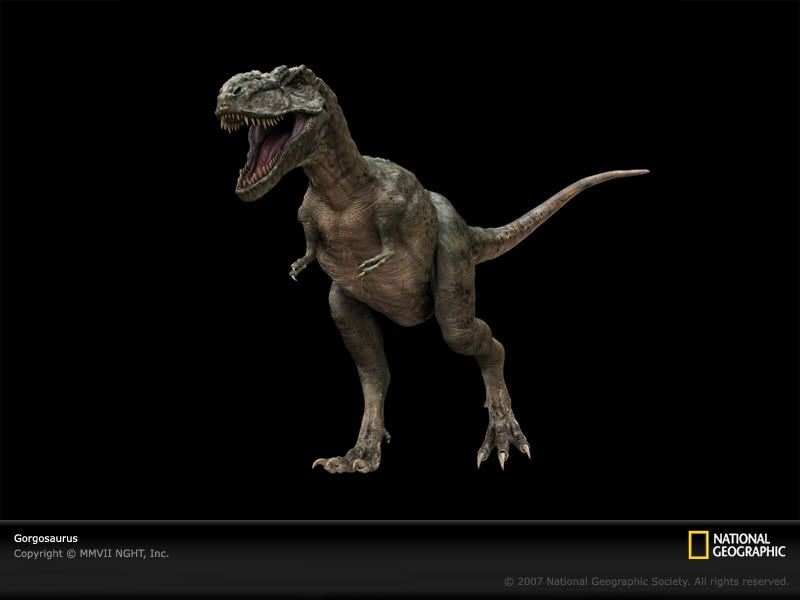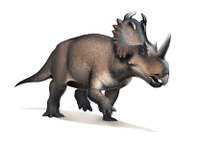Post by dinosauria101 on Aug 10, 2019 20:39:15 GMT 5
Gorgosaurus libratus
Gorgosaurus is a genus of tyrannosaurid theropod dinosaur that lived in western North America during the Late Cretaceous Period, between about 76.5 and 75 million years ago. Fossil remains have been found in the Canadian province of Alberta and possibly the U.S. state of Montana. Paleontologists recognize only the type species, G. libratus, although other species have been erroneously referred to the genus. Like most known tyrannosaurids, Gorgosaurus was a bipedal predator weighing more than a metric ton as an adult; dozens of large, sharp teeth lined its jaws, while its two-fingered forelimbs were comparatively small. Gorgosaurus was most closely related to Albertosaurus, and more distantly related to the larger Tyrannosaurus. Gorgosaurus was smaller than Tyrannosaurus or Tarbosaurus, closer in size to Albertosaurus and Daspletosaurus. Adults reached 8 to 9 m (26 to 30 ft) from snout to tail. Paleontologists have estimated full-grown adults to weigh about 2.5 tonnes (2.8 short tons), perhaps approaching 2.8–2.9 tonnes (3.1–3.2 short tons). The largest known skull measures 99 cm (39 in) long, just slightly smaller than that of Daspletosaurus.

Centrosaurus apertus
Centrosaurus ( /ˌsɛtrɵˈsɔrəs/ SEN-tro-SAWR-əs) is a genus of herbivorous ceratopsian dinosaurs from the late Cretaceous of Canada. Their remains have been found in the Dinosaur Park Formation and uppermost Oldman Formation, dating from 76.5 to 75.5 million years ago. The name Centrosaurus means "pointed lizard" (from Greek kentron/κεντρον = "point or prickle" + sauros/σαυρος = "lizard"), and refers to the series of small hornlets placed along the margin of their frills, not to the nasal horns (which were unknown when the dinosaur was named). The genus is not to be confused with the stegosaur Kentrosaurus, the name of which is derived from the same Greek word. The massive bodies of Centrosaurus were borne by stocky limbs, although at up to 18–20 ft (6m) they were not particularly large dinosaurs. Like other centrosaurines, Centrosaurus bore single large horns over their noses. These horns curved forwards or backwards depending on the species. A pair of small horns is also found over the eyes; in Centrosaurus apertus these are directed upwards, whereas they are directed to the sides in C. brinkmani. The frills of Centrosaurus were moderately long, with fairly large fenestrae and small hornlets along the outer edges. C. apertus is distinguished by having two large hornlets which hook forwards over the frill, while in C. brinkmani these hornlets are small and covered with small, finger-like growths.

Credit to Wikipedia
Gorgosaurus is a genus of tyrannosaurid theropod dinosaur that lived in western North America during the Late Cretaceous Period, between about 76.5 and 75 million years ago. Fossil remains have been found in the Canadian province of Alberta and possibly the U.S. state of Montana. Paleontologists recognize only the type species, G. libratus, although other species have been erroneously referred to the genus. Like most known tyrannosaurids, Gorgosaurus was a bipedal predator weighing more than a metric ton as an adult; dozens of large, sharp teeth lined its jaws, while its two-fingered forelimbs were comparatively small. Gorgosaurus was most closely related to Albertosaurus, and more distantly related to the larger Tyrannosaurus. Gorgosaurus was smaller than Tyrannosaurus or Tarbosaurus, closer in size to Albertosaurus and Daspletosaurus. Adults reached 8 to 9 m (26 to 30 ft) from snout to tail. Paleontologists have estimated full-grown adults to weigh about 2.5 tonnes (2.8 short tons), perhaps approaching 2.8–2.9 tonnes (3.1–3.2 short tons). The largest known skull measures 99 cm (39 in) long, just slightly smaller than that of Daspletosaurus.

Centrosaurus apertus
Centrosaurus ( /ˌsɛtrɵˈsɔrəs/ SEN-tro-SAWR-əs) is a genus of herbivorous ceratopsian dinosaurs from the late Cretaceous of Canada. Their remains have been found in the Dinosaur Park Formation and uppermost Oldman Formation, dating from 76.5 to 75.5 million years ago. The name Centrosaurus means "pointed lizard" (from Greek kentron/κεντρον = "point or prickle" + sauros/σαυρος = "lizard"), and refers to the series of small hornlets placed along the margin of their frills, not to the nasal horns (which were unknown when the dinosaur was named). The genus is not to be confused with the stegosaur Kentrosaurus, the name of which is derived from the same Greek word. The massive bodies of Centrosaurus were borne by stocky limbs, although at up to 18–20 ft (6m) they were not particularly large dinosaurs. Like other centrosaurines, Centrosaurus bore single large horns over their noses. These horns curved forwards or backwards depending on the species. A pair of small horns is also found over the eyes; in Centrosaurus apertus these are directed upwards, whereas they are directed to the sides in C. brinkmani. The frills of Centrosaurus were moderately long, with fairly large fenestrae and small hornlets along the outer edges. C. apertus is distinguished by having two large hornlets which hook forwards over the frill, while in C. brinkmani these hornlets are small and covered with small, finger-like growths.

Credit to Wikipedia


